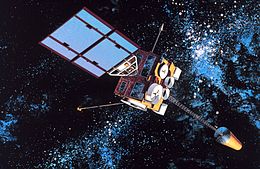 GOES-8, a decommissioned weather satellite. | |
| Manufacturer | |
|---|---|
| Country of origin | United States |
| Operator | |
| Specifications | |
| Bus | |
| Regime | Geostationary |
| Production | |
| Status | In service |
| Launched | 18 |
| Operational | 4 |
| Retired | 13 |
| Failed | 1 |
| Maiden launch | GOES-1 |
| Last launch | GOES-U |
| Related spacecraft | |
| Derived from | Synchronous Meteorological Satellite |
| Derivatives | Geostationary Extended Observations |

The Geostationary Operational Environmental Satellite (GOES), operated by the United States' National Oceanic and Atmospheric Administration (NOAA)'s National Environmental Satellite, Data, and Information Service division, supports weather forecasting, severe storm tracking, and meteorology research. Spacecraft and ground-based elements of the system work together to provide a continuous stream of environmental data. The National Weather Service (NWS) and the Meteorological Service of Canada use the GOES system for their North American weather monitoring and forecasting operations, and scientific researchers use the data to better understand land, atmosphere, ocean, and climate dynamics.
The GOES system uses geosynchronous equatorial satellites that, since the launch of SMS-1 in 1974, have been a basic element of U.S. weather monitoring and forecasting.
The procurement, design, and manufacture of GOES satellites is overseen by NASA.
NOAA is the official provider of both GOES terrestrial data and GOES space weather data. Data can also be accessed using the SPEDAS software.